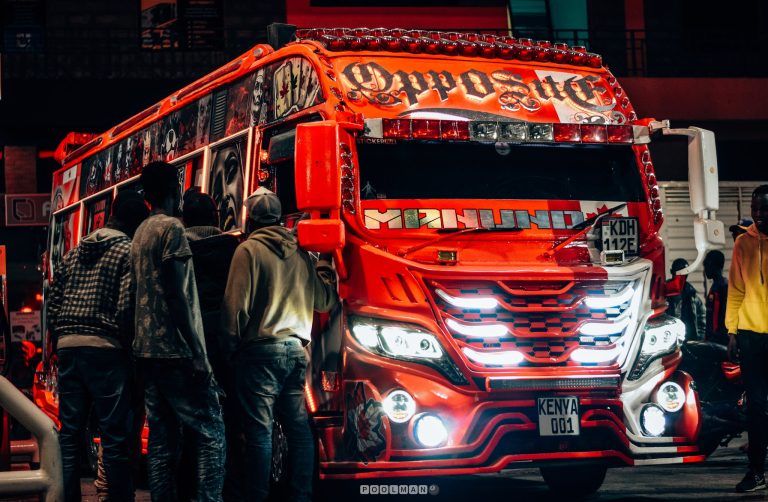Nairobi’s matatu culture is one of the most vibrant, expressive, and defining features of Kenya’s capital city. More than just public transport, matatus — the colorful, privately owned minibuses that dominate Nairobi’s roads — are living symbols of creativity, hustle, and urban pride. Every day, millions of commuters rely on them, but these vehicles also serve as cultural icons that mirror the city’s rhythm, humor, and struggles. From their graffiti-covered exteriors to the pulsating beats inside, matatus tell the story of a people who transform movement into art, commerce into culture, and travel into community.
In addition, the matatu scene embodies the energy, resilience, and imagination that make Nairobi unique. It’s a culture born from the city’s entrepreneurial spirit and nurtured by its youth. Over time, matatus have evolved from simple vans into powerful symbols of self-expression — blending music, fashion, design, and even political commentary. They capture Nairobi’s identity: fast, fierce, creative, and full of passion. Below is an in-depth look at what makes Nairobi’s matatu culture such a rich part of the city’s history and heartbeat.
The Birth of Matatu Culture
The matatu story began in the 1960s after Kenya gained independence. As urban migration increased, demand for public transport grew rapidly. The term “matatu” comes from the Swahili phrase mapeni matatu, meaning “three coins,” the fare once charged for short trips. Private entrepreneurs filled the transport gap left by government buses, and over time, their vehicles became a symbol of independence, freedom, and enterprise. What started as a simple way to move people evolved into a full-fledged urban phenomenon that reflects Kenya’s social and economic transitions.
A Canvas of Art and Imagination
One of the most striking features of Nairobi’s matatu culture is its visual artistry. Each matatu is a mobile masterpiece, decorated with airbrushed portraits of global icons, graffiti, and neon lights. From Tupac Shakur and Bob Marley to Kenyan legends like Eliud Kipchoge and Lupita Nyong’o, the art tells stories of aspiration, pride, and rebellion. In neighborhoods like Rongai, Ngong, and Eastlands, entire fleets compete for attention through creative designs, LED lighting, and futuristic interiors. This artistic rivalry has turned matatus into symbols of innovation and youth expression.
The Soundtrack of the Streets
Step inside a matatu, and you’re immediately immersed in sound. The music — usually booming hip-hop, reggae, Gengetone, or gospel — defines the matatu experience. Many feature massive sound systems, DJs, and even LED screens playing the latest music videos. For Nairobi’s youth, matatus double as moving clubs and community spaces where music trends are born. In addition, matatu crews often collaborate with local artists to promote new songs, making these vehicles powerful engines for Kenya’s entertainment industry.
The Spirit of Hustle and Freedom
Behind every matatu lies a story of hustle and hard work. The industry employs thousands of Kenyans — drivers, conductors (makangas), painters, sound technicians, and mechanics — each contributing to the system’s vibrancy. Matatus operate on a mix of creativity and survival, embodying Nairobi’s entrepreneurial spirit. They are independently owned, often managed through small groups or cooperatives, representing a grassroots economy that thrives on determination and adaptability.
Matatus as Symbols of Urban Identity
Each matatu route in Nairobi has its own style, character, and attitude. For example, matatus from Rongai are known for their flashy lights and booming music, while those from Eastlands emphasize graffiti and cultural pride. The art, design, and even slogans on matatus — such as “God’s Plan,” “Hustle Nation,” or “Only God Can Judge Me” — speak to the aspirations and humor of the everyday Kenyan. Moreover, matatus have become an essential part of Nairobi’s youth identity, influencing slang, fashion, and street culture.
The Matatu as a Social Space
More than transport, matatus are social spaces where Nairobians from different backgrounds interact. A single ride can bring together office workers, students, artists, and traders — all sharing the same journey, music, and energy. Inside, friendships are formed, debates spark, and laughter fills the air. For many Kenyans, daily matatu rides are part of the city’s heartbeat — chaotic yet full of life.
Innovation and Technology
As Nairobi grows into a smart city, matatu culture has adapted to modern trends. Cashless payment systems like M-Pesa and apps such as SWVL and Little Shuttle have revolutionized fare collection. Social media now plays a huge role in the culture — matatu crews promote their rides on Instagram and TikTok, showcasing new designs and music. Moreover, annual events like the Nganya Awards celebrate matatu art, design, and creativity, reinforcing their role in shaping modern Kenyan pop culture.
Challenges and Resilience
While matatus symbolize creativity and freedom, the industry faces challenges. Issues like traffic congestion, reckless driving, and regulation disputes often arise. However, the sector’s resilience remains unmatched. Government efforts to formalize the industry have pushed operators toward safer and more organized practices without erasing its creative essence. The balance between order and expression continues to define matatu culture’s evolution.
A Global Cultural Icon
Over the years, Nairobi’s matatu culture has gained international recognition. Documentaries, photo exhibitions, and art festivals around the world now showcase Kenya’s matatus as symbols of African innovation. Designers and musicians draw inspiration from their graffiti, colors, and slogans. In addition, global media outlets regularly feature matatus as examples of how art and entrepreneurship thrive in African cities.
Why Matatu Culture Matters
Matatu culture is not just about transport; it’s a mirror of Kenyan society — bold, expressive, and constantly evolving. It reflects how Nairobi’s people turn challenges into creativity and chaos into community. It tells stories of ambition, humor, resistance, and pride. For many, riding a matatu isn’t merely about reaching a destination — it’s about being part of a living, moving work of art that represents the soul of the city.
Nairobi’s matatu culture remains one of Africa’s most dynamic examples of urban creativity. It’s a celebration of art, music, entrepreneurship, and resilience — a vivid reminder that even in the busiest corners of the city, expression thrives. To experience the true spirit of Nairobi, you must ride a matatu — where history, hustle, and passion collide in a symphony of color, sound, and energy.



















